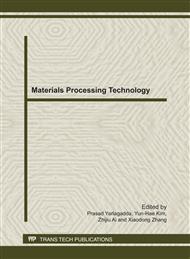p.178
p.184
p.188
p.192
p.198
p.203
p.209
p.214
p.219
Material Modeling and Correlative Mechanical Testing on AHSS Sheet Forming Simulation
Abstract:
The finite element method is widely used to numerically simulate sheet forming processes. The increasing use of advanced high strength steel (AHSS) sheet places an increased demand on accuracy of forming simulation and springback prediction. Appropriate identification and characterization of material behavior are of vital importance to improve the simulation accuracy. An overview of yield criteria and hardening laws of material constitutive models are presented in this work. Because of the anisotropic yield behavior and Bauschinger effect of AHSS sheet materials, suitable anisotropic yield model in combination with anisotropic hardening law is one essential component for successful AHSS sheet forming simulation and springback prediction. Necessary mechanical tests for determination of parameters of material constitutive models are given in this paper, the advantages and already known limitations of different test procedures are also discussed. Recommendations on choose or further improve the constitutive models are given for enhance the efficiency and accuracy of AHSS sheet forming simulation.
Info:
Periodical:
Pages:
198-202
Citation:
Online since:
September 2011
Authors:
Price:
Сopyright:
© 2011 Trans Tech Publications Ltd. All Rights Reserved
Share:
Citation:


